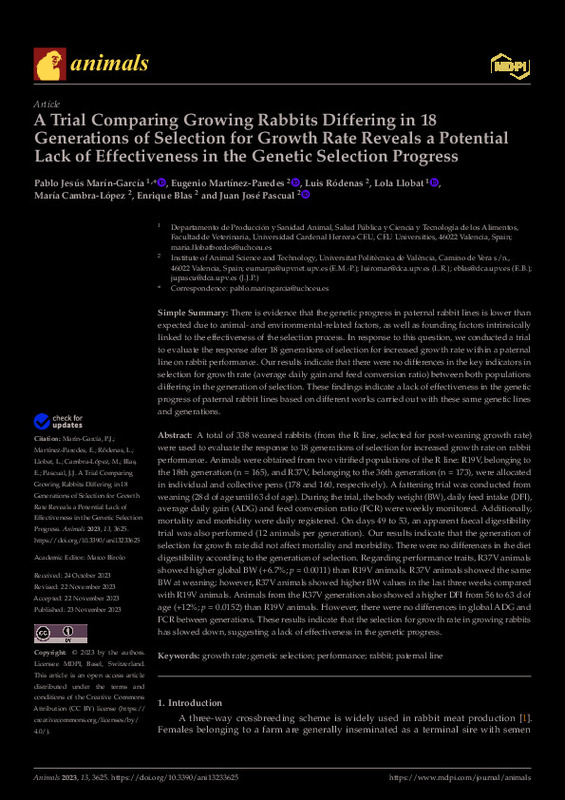JavaScript is disabled for your browser. Some features of this site may not work without it.
Buscar en RiuNet
Listar
Mi cuenta
Estadísticas
Ayuda RiuNet
Admin. UPV
A trial comparing growing rabbits differing in 18 generations of selection for growth rate reveals a potential lack of effectiveness in the genetic selection progress
Mostrar el registro sencillo del ítem
Ficheros en el ítem
| dc.contributor.author | Marín-García, Pablo Jesús
|
es_ES |
| dc.contributor.author | Martinez-Paredes, Eugenio
|
es_ES |
| dc.contributor.author | Ródenas Martínez, Luis
|
es_ES |
| dc.contributor.author | Llobat, Lola
|
es_ES |
| dc.contributor.author | Cambra López, María
|
es_ES |
| dc.contributor.author | Blas Ferrer, Enrique
|
es_ES |
| dc.contributor.author | Pascual Amorós, Juan José
|
es_ES |
| dc.date.accessioned | 2023-12-26T19:02:20Z | |
| dc.date.available | 2023-12-26T19:02:20Z | |
| dc.date.issued | 2023-12 | es_ES |
| dc.identifier.uri | http://hdl.handle.net/10251/201118 | |
| dc.description.abstract | [EN] Simple Summary There is evidence that the genetic progress in paternal rabbit lines is lower than expected due to animal- and environmental-related factors, as well as founding factors intrinsically linked to the effectiveness of the selection process. In response to this question, we conducted a trial to evaluate the response after 18 generations of selection for increased growth rate within a paternal line on rabbit performance. Our results indicate that there were no differences in the key indicators in selection for growth rate (average daily gain and feed conversion ratio) between both populations differing in the generation of selection. These findings indicate a lack of effectiveness in the genetic progress of paternal rabbit lines based on different works carried out with these same genetic lines and generations.Abstract A total of 338 weaned rabbits (from the R line, selected for post-weaning growth rate) were used to evaluate the response to 18 generations of selection for increased growth rate on rabbit performance. Animals were obtained from two vitrified populations of the R line: R19V, belonging to the 18th generation (n = 165), and R37V, belonging to the 36th generation (n = 173), were allocated in individual and collective pens (178 and 160, respectively). A fattening trial was conducted from weaning (28 d of age until 63 d of age). During the trial, the body weight (BW), daily feed intake (DFI), average daily gain (ADG) and feed conversion ratio (FCR) were weekly monitored. Additionally, mortality and morbidity were daily registered. On days 49 to 53, an apparent faecal digestibility trial was also performed (12 animals per generation). Our results indicate that the generation of selection for growth rate did not affect mortality and morbidity. There were no differences in the diet digestibility according to the generation of selection. Regarding performance traits, R37V animals showed higher global BW (+6.7%; p = 0.0011) than R19V animals. R37V animals showed the same BW at weaning; however, R37V animals showed higher BW values in the last three weeks compared with R19V animals. Animals from the R37V generation also showed a higher DFI from 56 to 63 d of age (+12%; p = 0.0152) than R19V animals. However, there were no differences in global ADG and FCR between generations. These results indicate that the selection for growth rate in growing rabbits has slowed down, suggesting a lack of effectiveness in the genetic progress. | es_ES |
| dc.description.sponsorship | We are grateful to the Veterinary Medicine Faculty of Universidad Cardenal Herrera-CEU. | es_ES |
| dc.language | Inglés | es_ES |
| dc.publisher | MDPI AG | es_ES |
| dc.relation.ispartof | Animals | es_ES |
| dc.rights | Reconocimiento (by) | es_ES |
| dc.subject | Growth rate | es_ES |
| dc.subject | Genetic selection | es_ES |
| dc.subject | Performance | es_ES |
| dc.subject | Rabbit | es_ES |
| dc.subject | Paternal line | es_ES |
| dc.subject.classification | PRODUCCION ANIMAL | es_ES |
| dc.title | A trial comparing growing rabbits differing in 18 generations of selection for growth rate reveals a potential lack of effectiveness in the genetic selection progress | es_ES |
| dc.type | Artículo | es_ES |
| dc.identifier.doi | 10.3390/ani13233625 | es_ES |
| dc.rights.accessRights | Abierto | es_ES |
| dc.contributor.affiliation | Universitat Politècnica de València. Instituto de Ciencia y Tecnología Animal - Institut de Ciència i Tecnologia Animal | es_ES |
| dc.contributor.affiliation | Universitat Politècnica de València. Escuela Técnica Superior de Ingeniería Agronómica y del Medio Natural - Escola Tècnica Superior d'Enginyeria Agronòmica i del Medi Natural | es_ES |
| dc.contributor.affiliation | Universitat Politècnica de València. Departamento de Ciencia Animal - Departament de Ciència Animal | es_ES |
| dc.description.bibliographicCitation | Marín-García, PJ.; Martinez-Paredes, E.; Ródenas Martínez, L.; Llobat, L.; Cambra López, M.; Blas Ferrer, E.; Pascual Amorós, JJ. (2023). A trial comparing growing rabbits differing in 18 generations of selection for growth rate reveals a potential lack of effectiveness in the genetic selection progress. Animals. 13(12):1-11. https://doi.org/10.3390/ani13233625 | es_ES |
| dc.description.accrualMethod | S | es_ES |
| dc.relation.publisherversion | https://doi.org/10.3390/ani13233625 | es_ES |
| dc.description.upvformatpinicio | 1 | es_ES |
| dc.description.upvformatpfin | 11 | es_ES |
| dc.type.version | info:eu-repo/semantics/publishedVersion | es_ES |
| dc.description.volume | 13 | es_ES |
| dc.description.issue | 12 | es_ES |
| dc.identifier.eissn | 2076-2615 | es_ES |
| dc.relation.pasarela | S\505914 | es_ES |








